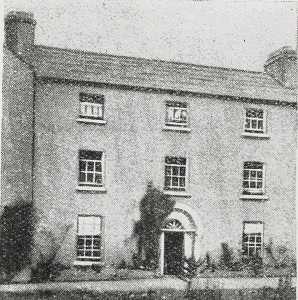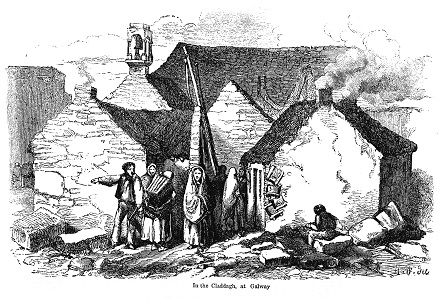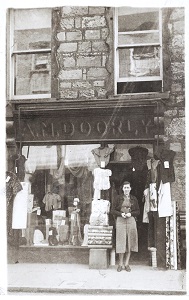Old Galway
OUR FORTIFIED CITY

by Tom Kenny
The town of Galway was virtually an independent city state, self-contained politically and ecclesiastically, relying on its own resources as it was cut off from the central English authority until the 16th century. Then, the Tudors began to extend their influence westwards so that the city gradually came totally under their dominion. The real symbol of that growing influence was the fortifications, four in number, raised to defend this all-important location against all enemies, notably France and Spain.
The first mention of fortifications occurs in 1548 when Edward VI asked the Mayor and Council of Galway to fortify the port; they were willing but pleaded a lack of funds, the government were willing to advise but not to pay, so nothing happened. The establishment of a garrison of English soldiers here proved unpopular with the natives and gave ‘rebels’ in the west an excuse to attack the city. Some Galwegian merchants whose Spanish trade had been ruined by the English were now trafficking guns and supplies to those rebels. And then, of course, there was the danger from Spain itself, so in 1584, the first fortifications were built at Ceann-a-Bhalla.
CYRIL MAHONY, A SUPERB COMIC ACTOR

by Tom Kenny
Cyril Mahony was born in February 1913 in the family home on Prospect Hill. His mother was Mary Teresa Cunniffe from Loughrea and his father Gerry was a member of the R.I.C. who at one time was stationed in Belfast. He eventually left the force and came back to his mother’s house on Prospect Hill. She was Anne Flaherty from Conamara, a native speaker and a well-known maternity nurse.
Cyril was one of six children – Vin, Cyril, Maudie, Des, Piaras and Ita. Cyril went to the Monastery School from where he got a scholarship to the Bish. He used to serve mass in St. Patrick’s Church. He was very athletic, a fine sprinter and a very good rugby player, rejoicing in the nickname ‘Twinkletoes’. He played at scrumhalf and captained the first ever Connacht team not to be beaten by Leinster. The game was played in Kilkenny and speaking at the dinner afterwards, Cyril got a bit over excited and while he regretted Leinster winning, he was delighted that Connacht won. Austin Carrie who was sitting beside him, nudged him and said “It was a draw sir, a moral victory perhaps, but a draw nevertheless”.
THE DOMINICAN NUNS IN GALWAY

by Tom Kenny
The first Dominican Nunnery in Galway was founded 380 years ago, in 1644, in New Tower Street, now known as Augustine Street. They were honoured with a visit from Papal Nuncio Rinucinni three years later. When the Cromwellians took over the city, the sisters were faced with two alternatives, to renounce their religious life and return to their families or exile. They choose the latter and left for Spanish monasteries.
In 1686, two sisters returned to Galway and John Kirwan, the mayor, offered them his house, “A fine stone house in the Jacobean style with a large courtyard” in Kirwan’s Lane. They began to build a community and did so successfully. However, they were once again dispersed in 1698. They remained in town and after some years were allowed to reassemble for a while but they were scattered again in January 1716 when the convent was used as a barracks to house a company of Brigadier Harrison’s regiment. The sisters were back by November of that year.
GALWAY DOMINICANS, A BRIEF HISTORY

by Tom Kenny
The Dominican Order was formally approved by Pope Honorius III in 1216, “to witness to the truth of the Christian Faith and to proclaim it at home and abroad”. St. Dominic died in 1216 and in 1224, the Dominicans first came to Ireland. They came to Connacht, to Athenry, in 1241, and they finally arrived in Galway in 1488.
They took possession of the Church of St. Mary on the Hill, an abandoned chapel outside the walls and later the priory became known as the ‘West Convent’ or ‘St. Mary’s outside the Gates’. In 1570, Elizabeth I declared the Order illegal and they dispersed though they continued to exercise a pastoral ministry in Galway. In 1617, they were back in the Claddagh. In 1641, Lord Forbes landed in Galway Bay with an expeditionary force and erected batteries at the Dominican church in an effort to capture the city.
CUNNINGHAM’S BUTCHER SHOP

by Tom Kenny
This superb image of Martin Cunningham’s butcher shop at Number 10, Shop Street was taken c.1900. In the 1901 census, the occupants of this building are listed as Martin Cunningham, aged 50; his wife Delia aged 30 and their children Michael aged 12, Mary Margaret 7, James 3, Delia 2 and Martin J. who had just been born. The family lived over the shop.
Martin Cunningham ran exactly the same advertisement in local newspapers over a number of years between 1899 and 1902. A sample of it, published in 1902, is illustrated here.
THE ATLANTA HOTEL

by Tom Kenny
Joseph Owens lived in Glenamaddy with his wife who was born Annie M. Tuohy. They had three children, Dick, Mary and her twin Joseph (born February 4th, 1912) who was known to one and all as Josie. The father died very young. Annie remarried, this time to a man named Doorly, and in 1922, the family bought a four-bay four-storey early 19th century house in Lower Dominick Street from Nora O’Donnell and moved to Galway. Annie was a busy woman, she opened a drapery shop where she designed clothes, made them and sold them in her shop, and she kept lodgers upstairs, all as she was rearing her children.
GALWAY RAILWAY STATION

by Tom Kenny
The station opened on August 1st, 1851. The buildings and the Great Southern Hotel were designed by John Skipton Mulvany. It was originally planned to have the station at Renmore, but the well-known Father Peter Daly convinced the railway authorities to construct Lough Athalia Bridge and bring the trains into the centre of town. The fact that he owned tenement buildings on the site where the Great Southern was built may well have had something to do with it. These tenements were levelled to make way for the hotel and station.
The station interior looked completely different then. There were four tracks under the roof, one for arrivals, one for departures and two storage roads. The roof was designed by the famous Richard Turner of Hammersmith Works in Ballsbridge. He was well-known for his work on the Palm House at Kew and also at the Botanic Gardens, Glasnevin. The roof had an 80 foot span and wrought iron ribs, tie bars and sheets. The centre section was glazed with heavy plate glass and the sides were of corrugated iron, an early use of this material in the west of Ireland.
THE PATRICIAN MUSICAL SOCIETY

by Tom Kenny
On this day, the 29th of February, 1952, a meeting was held in the Bish the purpose of which was “that a choral Society titled the Patrician Choral Society under the auspices of the Patrician Brothers Past-Pupils’ Union be here and now formed”. The motion was proposed, seconded and passed unanimously. Jack Browne was elected President, Thomas Lydon as Vice-President, Jack Doherty and Brother Cuthbert as directors and Jack Begley as Treasurer.
Towards the end of the 1940s, the Department of Education had sanctioned the building of the present St.Patrick’s School on a site then known as The Shambles. However, £20,000 of the cost had to be raised locally and so several functions were organised locally in order to raise funds … a 20-week draw, pantomimes, dramas and especially concerts by visiting artists. Brother Cuthbert was asked to prepare a choir to sing at these concerts and he formed one with 100 boys from the Monastery School, the Bish Primary and St. Joseph’s College. They were called the Patrician Brothers Boys Choir. They sang at these concerts, they made a 78 record and were recorded by Radio Éireann. Brother Cuthbert was now suggesting that it was time for Galway to step into the musical world by forming a musical society, and as a result the above-mentioned meeting came about.
